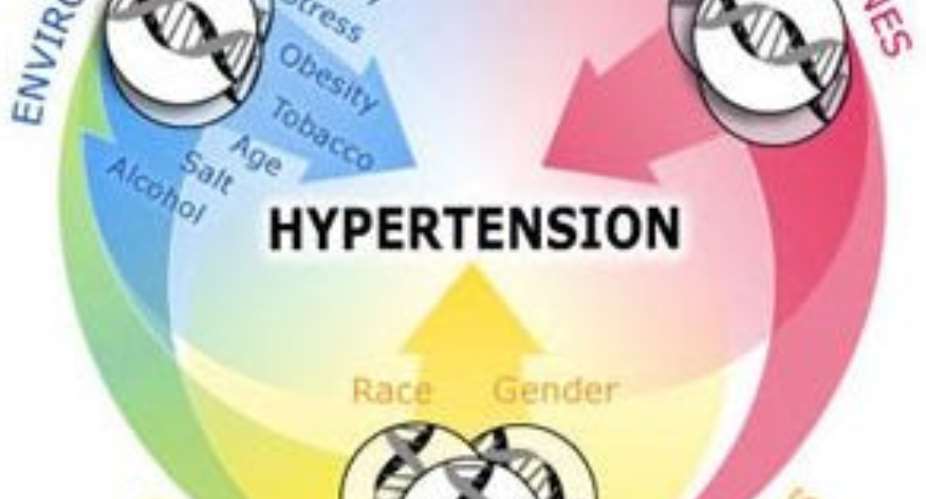We live in a developing country, Ghana, where many of the cases reported to the health facilities are in relation to cardiovascular problems. Diseases of the cardiovascular system have always been the cause of high mortality rates in the country. In most instances, these diseases have been rampant in various hospitals, health centers, and clinics but minimal attention is being given to such cases.
Hypertension, a major public health problem, has high prevalence all around the globe. Around 6.9 million deaths of the total of all annual mortality rates in the world occur due to elevated blood pressure. Prevalence, detection, management, and control of hypertension were assessed in 1013 individuals living in 12 villages in Ashanti region by a team from Komfo Anokye Teaching Hospital, Kumasi, Ghana,.The participants underwent measurements of height, weight, and blood pressure and answered a detailed questionnaire. After the exercise, prevalence of hypertension was 28.7% in both men and women. Hypertension is higher in semi-urban villages. Also, in a recent study, the prevalence of hypertension was found to be 28% in North America and 44% in western Europe. Increased blood pressure is the leading risk for death and disability globally as it was highlighted in the recent global burden of disease study and emphasized by the World Health Organization
One of the major barriers to effect control of hypertension is simply that people are not aware their blood pressure is high. Yet, a simple affordable step to incorporate routine blood pressure assessment into community programs and workplaces, as well as all healthcare settings, could play a major role.
Recently during my clinical experience practice in one district hospital in the Manhyia South constituency in the Ashanti region, a sample of 50 folders was picked randomly and being checked one after the cases that were diagnosed in these folders. After all the checks in these folders, about 27 were cases of hypertension. This draws the attention of how individuals are imbibed with this condition.
Elevated blood pressure is a major risk factor causing chronic heart disease. When one gets an elevated BP, there is a high possibility of the person getting heart failure, visual impairment, renal impairment, peripheral vascular disease, etc.
According to the Standard Treatment Guide (STG), normal BP is a systolic BP <140mmHg and diastolic BP<90mmHg.Hypertension is a silent killer as very rarely any symptom can be seen in its early stages until severe medical crisis like heart attack, stroke, Chronic Kidney Disease. Many individuals are unaware of elevated BP so it is only through measurements that detection can be done.
Day-in-day-out we perform activities that usually cause a rise in the blood pressure but these actions are left unchecked. Some of these factors /actions include;
- High salt intake
- High animal fat intake
- Smoking
- Alcohol consumption
- Lack of exercise
Several factors surrounding the treatment of hypertension have continually caused controversy over the past decade and remain unresolved. Some of the examples of these issues include the role of combination therapy, the choice of first-line antihypertensive therapy, BP in the context of other cardiovascular risk factors and the role of assessment of subclinical and overt organ damage in defining treatment strategies. Nothing, however, has stimulated debate to the extent seen over BP targets. Contemporary guidelines generally advocate lower BP targets compared with earlier recommendations when hypertension was first recognized as an important yet modifiable cardiovascular risk factor.
A limited information available from developing countries suggest that a similar epidemic is inevitable if current trends go unchecked. Treatment of patients with clinical manifestations is an important element in overall management but units own is an insufficient and incomplete response. Sudden death is often the first manifestations of these cardiovascular diseases and even when treatment is applicable and effective, it is usually palliative rather than curative. Thus, treatment and prevention directed at the underlying risk factors including high BP, constitute a complementary and more fundamental approach of reducing the burden of illness
Its high time we created the awareness and put in place better measures in reducing the rate of such cases in our healthcare settings and the country as a whole being it education, proper treatment therapies, etc., to reduce the mortality rate due to hypertension in our beloved country.
ROMEO NSIAH
LEVEL 200 PHYSICIAN ASSISTANT STUDENT
UNIVERSITY OF CAPE COAST





 'Kill whoever will rig Ejisu by-election' – Independent Candidate supporters inv...
'Kill whoever will rig Ejisu by-election' – Independent Candidate supporters inv...
 Ashanti Region: ‘Apologize to me for claiming I owe electricity bills else... – ...
Ashanti Region: ‘Apologize to me for claiming I owe electricity bills else... – ...
 Ghana is a mess; citizens will stand for their party even if they’re dying — Kof...
Ghana is a mess; citizens will stand for their party even if they’re dying — Kof...
 Internet shutdown an abuse of human rights — CSOs to gov't
Internet shutdown an abuse of human rights — CSOs to gov't
 Free SHS policy: Eating Tom Brown in the morning, afternoon, evening will be a t...
Free SHS policy: Eating Tom Brown in the morning, afternoon, evening will be a t...
 Dumsor: A British energy expert 'lied' Ghanaians, causing us to abandon energy p...
Dumsor: A British energy expert 'lied' Ghanaians, causing us to abandon energy p...
 What a speech! — Imani Africa boss reacts to Prof. Opoku Agyemang’s presentation
What a speech! — Imani Africa boss reacts to Prof. Opoku Agyemang’s presentation
 Dumsor: Tell us the truth — Atik Mohammed to ECG
Dumsor: Tell us the truth — Atik Mohammed to ECG
 Dumsor: Don't rush to demand timetable; the problem may be temporary — Atik Moha...
Dumsor: Don't rush to demand timetable; the problem may be temporary — Atik Moha...
 Space X Starlink’s satellite broadband approved in Ghana — NCA
Space X Starlink’s satellite broadband approved in Ghana — NCA
